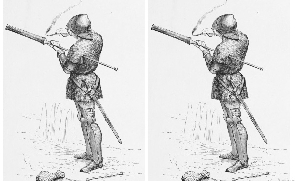 Hand cannon being used by a soldier/Photo credit: Wikipedia
Hand cannon being used by a soldier/Photo credit: Wikipedia
In the 12th century, there was a wave of Christian crusaders determined to convert other religions and pagan worshipers into their folds. This campaign was spearheaded by the Mongol army, which was led by the Turk, Kitbuga. Their raid started with Syria in 1259 and swept through Damascus and Aleppo till the caravan made a stopover at the Mediterranean Sea. They had plans to take over Egypt’s capital, Cairo, but decided to give the rulers an option to submit or be forced into submission. The Mongol envoy sent to Mamlūk sultan, al-Muẓaffar Sayf al-Dīn Quṭuz, returned with a strong warning from the Egyptian ruler, emphasizing they were not walkovers.
Still angered by the proposal of the Mongolian army, the Mumluks, led by Qutuz, waged a military expedition against the Mongolian forces in Gaza. They fought a Mongol army of 20,000 at Ain Jalut, which is also known as Goliath’s spring. The leverage the Mamluks exercised over the Mongol army was due to army General Baybars’ familiarity with the terrain since his teenage years when he was once held there as a fugitive. His strategy enabled the Mamluks to subdue the Mongol forces on the battlefield, according to Britannica.
The plan was to capitalize on one of the tactics of the Mongols where they feign interest in trapping their enemies. While the Mongols followed the bait, his army hid behind trees in wait to ambush the enemy forces. When their adversaries fell for the trick, the Mamluk army attacked them from all sides, leaving them with a heavy blow of assault from a sea of arrows. Though the Mongols fought hard and viciously, the Mumluks won the battle that day.
One of the arsenals the Mumluks used to their advantage was the hand cannons known as “midfa” to disrupt the front of the Mongol forces and their horses. It was the first portable hand cannon loaded with explosive gunpowder which the Egyptians used to repel the Mongols at the Battle of Ain Jalut in 1260. The cannons had an explosive gunpowder composition almost identical to the ideal compositions for modern explosive gunpowder. They were spurred on sultan Qutuz, who removed his helmet and asked his men to fight for the preservation of Islam. The Mongol army lost their general, Ked Buqu, who was killed in the battle, according to sources. This ended the campaign of the Mongols, who beat retreat after the heavy defeat.
The Mongol forces later discontinued their expedition in Iran and Mesopotamia, leaving Egypt secure in Muslim Mamlūk hands. The Mamluks milked the success of the war to their advantage; this is the legend that has been passed on from generation to generation.